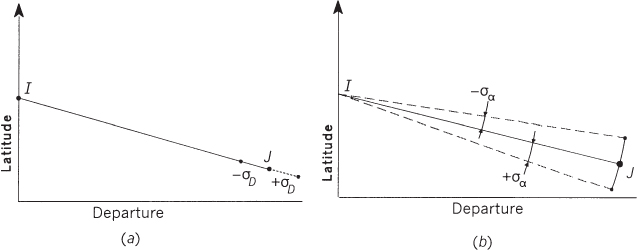CHAPTER 8ERROR PROPAGATION IN TRAVERSE SURVEYS
8.1 INTRODUCTION
Even though the specifications for a project may allow lower accuracies, the presence of blunders in observations is never acceptable. Thus, an important question for every surveyor is, “How can I tell when blunders are present in the data?” In this chapter, we begin to address that question, and in particular, stress traverse analysis. This topic is discussed further in Chapters 21 and 25.
In Chapter 6, it was shown that the estimated error in a function of observations is dependent on the individual errors in the observations. Generally, observations in horizontal surveys (e.g., traverses) are independent. That is, the measurement of a distance observation is independent of the azimuth observation. But the latitude and departure of a line, which are computed from the distance and azimuth observations, are not independent. Figure 8.1 shows the effects of the errors in distance and azimuth observations on the computed latitude and departure. In Figure 8.1, it can be seen that there is correlation between the latitude and departure; that is, if either distance or azimuth observation changes, it causes changes in both latitude and departure.

FIGURE 8.1 Latitude and departure uncertainties due to (a) the distance standard error (σD) and (b) the azimuth standard error (σα). Note that if either the distance or azimuth ...
Get Adjustment Computations, 6th Edition now with the O’Reilly learning platform.
O’Reilly members experience books, live events, courses curated by job role, and more from O’Reilly and nearly 200 top publishers.

